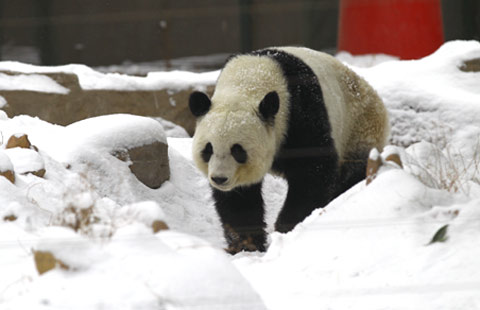Beijing-area air better than before
Updated: 2014-03-03 03:54
By Cheng Yingqi (China Daily)
|
|||||||||||
The pollution that hit Hebei province, Beijing and Tianjin in the past week was less severe than last year's incident, monitoring results revealed.
From Feb 20 to 26, Beijing, Tianjin and Hebei were shrouded in smog.
However, environment-monitoring results of the Chinese Academy of Sciences showed that the average concentration of PM2.5 — fine particulate matter with a diameter less than 2.5 microns that can lodge in the lungs — was 11 percent less than it was when smog hit the region in spring 2013, and the peak concentration decreased by 16.4 percent.
"The concentration of pollutants in the smog decreased by 20 to 30 percent in general over the last year," said Wang Yuesi, a researcher from the Institute of Atmospheric Physics under the Chinese Academy of Sciences.
Wang was speaking on Saturday at a forum in Beijing held by the Chinese Academy of Sciences, which discussed the cause of the smog.
The institute monitored the concentration of PM2.5 and other pollutants across the country, with 23 monitoring stations in North China. The comparison was based on data collected in January and February this year and January 2013, when severe pollution lasted nearly a month in North China.
Both of these smog events had similar climatic conditions, Wang said.
"The monitoring results show that the emergency measures taken to cope with air pollution were effective. But the effect may not be so obvious to the general public because the PM2.5 concentration still caused a deterioration in visibility," he said.
Visibility in the smog was 2 kilometers, while Wang said the visibility will not be improved unless the PM2.5 concentration falls to less than 100 micrograms per cubic meter. In February, it was 230 mg per cubic meter.
Beijing's contingency plan includes forcing nearby plants to cut their production.
However, Wang said that only long-term solutions will end the pollution.
"The major PM2.5 source comes from coal power stations," he said. "The overall area of Beijing, Tianjin and Hebei accounts for some 0.05 percent of the world, while this region consumes 11 percent of its coal, so you don't have to use your imagination to understand why we are suffering from air pollution. We are living inside a huge chimney."
He Hong, a researcher at the Research Center for Eco-Environmental Sciences, Chinese Academy of Sciences, said: "Our research shows that 'second particles' contribute around 60 percent to the formation of PM2.5 in Beijing and Tianjin."
Second particles are pollutants generated by chemical reactions between different pollutants released into the atmosphere.
"As a result, reducing the emissions of oxynitride and oxysulfide from coal fuel and vehicles is necessary," He said.
However, due to the complex chemical reactions, scientists are not sure about the exact contributing factors of smog. To understand better, the Chinese Academy of Sciences will apply for construction in 2016 of a "smog chamber" to simulate pollution conditions.
Related Stories
Polluters to face harsher penalties 2014-02-28 07:22
The desolation of smog: World battles against air pollution 2014-02-27 17:51
Giant pollution-free vegetable base settles in Ruzhou 2014-02-27 09:15
Beijing lifts heavy air pollution alert 2014-02-27 08:49
Pollution fines work in Europe: official 2014-02-27 07:18
Beijing sees first rain this spring, lifts heavy air pollution alert 2014-02-27 03:15
Today's Top News
War in Ukraine a long shot, experts say
Beijing-area air better than before
Abe 'shut the door': CPPCC spokesman
EU condemns terrorist attacks in China
Putin not yet decided on use of force in Ukraine
28 dead in Kunming violence
China, UK hold dialogue on ties
Ukraine protests over airspace violation
Hot Topics
Lunar probe , China growth forecasts, Emission rules get tougher, China seen through 'colored lens', International board,
Editor's Picks

|

|

|

|

|

|





